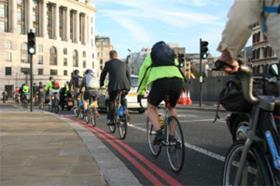Both the RHA and FTA have reiterated their opposition to TfL’s Direct Vision Standard (DVS) arguing there are more effective ways to reduce vulnerable road user casualties on the capital’s roads.
The statements came as TfL marked three months to go until hauliers are able to apply for safety permits, a core requirement of the scheme.
The DVS uses a star system to rate HGVs over 12 tonnes from zero (lowest) to five (highest), based on how much a driver can see directly through their cab windows.
Zero rated vehicles will need to be fitting what TfL describes as a Safe System, typically including a camera monitoring system, an audible left-turn vehicle manoeuvring warning and sensors before October 2020.
Fitting the Safe System will not change a vehicle’s DVS star rating but will bring the safety standard of the vehicle up, allowing a safety permit to be granted.
All HGVs over 12 tonnes can apply for a free Safety Permit from 28 October in order to operate in London.
Read more
- TfL opens latest Direct Vision Standard consultation, but FTA urges a refocus on new HGV technology
- Starting gun fired on new truck cab designs; EU direct vision standard adopted for 2025
- ‘Super-sewer’ firm Tideway champions direct vision, low-entry HGV cabs
Operators are expected to contact their vehicle manufacturers to check the star rating of their HGVs.
Christina Calderato, head of transport strategy and planning at TfL, said: “Our DVS and its associated HGV Safety Permit is vital for saving lives on London’s streets and achieving Vision Zero.
“We thank the freight industry for their input and support throughout the stages of development. We are just three months away from the first permits being issued and encourage all operators to check the star rating of their vehicle, so they are prepared and compliant.”
Alternatives would deliver more
Natalie Chapman, head of urban policy at the FTA, said: “The logistics sector is fully committed to improving road safety and takes its responsibility to do so very seriously; that’s why FTA is calling for the mayor of London to realise that other strategies would deliver a far greater outcome.
“Technological development, along with internationally-agreed design standards and the retiming of deliveries to quieter periods, would provide a more robust and long-term safety solution than DVS alone; visibility from the cab should be viewed as just one aspect of holistic approach to road safety.”

Duncan Buchanan, RHA policy director for England and Wales, said: “We all want safer roads but lorries operate nationally and internationally so should be regulated on that basis.
“Haulage needs coherent, consistent regulation, not a patchwork of locally devised standards and permit systems which cause concern and confusion.”
It came after TfL published 2018 casualty statistics showing that the number of people killed on London’s roads had fallen to the lowest level on record. Last year 111 people were killed and a further 3,954 suffered serious injuries, according to the data. TfL said that those walking, cycling and riding motorcycles made up around 80% of all people killed.
Looking at the Direct Vision Standard
The Direct Vision Standard will operate 24 hours a day, seven days a week and will be enforced on all roads within the Greater London Boundary.
Vehicles rated between one and five stars will be compliant until 2024, when vehicles rated two star and below will then require a Progressive Safe System.
Permits will be electronic and enforced by Automatic Number Plate Recognition cameras.
HGVs that are non-compliant with the scheme will be issued with a PCN of £550 per day, which will be reduced by 50% if paid within 14 days.
Enforcement starts on 26 October 2020.














